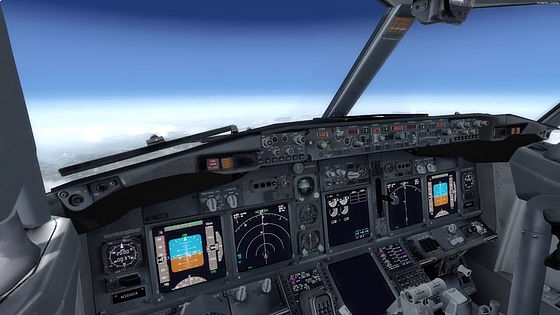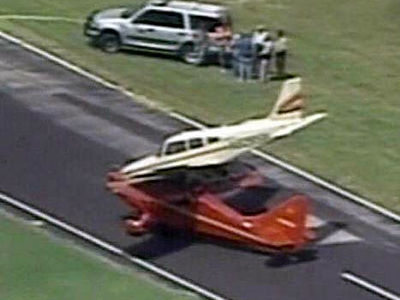"What should I do if the pilot faints and amateurs are to fly" Real pilots seriously comment on "Microsoft Flight Simulator"

There are always two pilots on the plane, and even if one of them is distracted, the remaining pilot is supposed to continue piloting, but the possibility that the second pilot will faint If not, it can not be said that it is completely zero. "Is there anyone in the customer who can steer the plane?"The active pilot uses a flight simulator to explain how to handle what you should do to hold the control stick in a desperate situation.
How to Land a 737 (Nervous Passenger Edition) - YouTube
Published this movie has pilot qualification and sometimes works on software developmentTim MorganMr. Using his own pilot experience, he explains the maneuvering method while reproducing situations with Microsoft's simulator software "Flight Simulator".

If you are flying over the sky, the aircraft is flying in "autopilot" (autopilot). First of all, cancel the auto pilot and let's manually land at the nearby airport. In addition, this movie explains the theme "Boeing 737 type machine (737-800)" widely used all over the world.

First of all, in order to communicate with the ground, a headset for pilot is attached to the head and radio setting is done. Wireless control panel is between Captain's seat and Co-pilot's seatControl pedestalThere are three for the captain, co-pilot, observer, so if you manipulate the one in front of you, OK.

Make sure that "VHF - 1" is lit with the switch lamp of "MIC SELECTOR". If this is not selected, no matter how much "speak to an emergency!" Speech will be sent to the audience seats and cause panic, so be careful.

Set the radio frequency with the panel above it. Anyway anything is fine, so I will first find the frequencies that lead to ATC (air traffic control).

When the radio is connected, hold down the "MIC" button on the control stick and "Mayday! Mayday! Mayday! I am a passanger onboard Janet flight 1603. Both pilots are unconscious and I am a passenger flying the aircraft. I am a passenger on ○ × Air 1603. Both pilots are losing consciousness and I am piloting an airplane right now. Let's declare an emergency situation.

Then from ATC it should be heard back like "Do you want me again?", So report the situation again. That way, the ATC staff probably will start looking for a pilot with a pilot of the 737 aircraft and will be able to arrange a system that can give you instructions wirelessly.

While doing pilot seeking, ATC may direct you to change destination and flight altitude. If you are told "○ ○ Aviation 1603, heading to heading 265", change the settings of the autopilot. The autopilot related setting panel is here.

Turn the dial to set the value to "265".

However, since the airplane is autopiloted according to the pre-set flight plan, we will not attempt to change course only by adjusting the numerical values. Next, press the SELECT button under the dial to change course to the set orientation.

Then the button will light up and the aircraft will start turning.

The next thing to do is to lower the altitude for landing. If you leave this to the autopilot, it is ok so turn the dial on the setting panel and enter the target altitude. On the following screen, since 38,000 feet of altitude (about 11,000 meters) is set, set kore to "10000" (10,000 feet: about 3000 meters), for example.

And when you press the "LVL CHG (altitude change)" button, we will automatically lower the altitude.

At this time, the throttle lever at the right hand position will automatically move toward you and start throttling the thrust of the engine, but leave it as it is normal operation OK.

The altitude and speed of the aircraft, the heading direction are in front of youPFD(Primary Flight Display), so sometimes you check Colle to see if there are any problems.

As the altitude drops and the landing timing approaches, ATC will tell you to slow down. When the direction "○ ○ Air 1603 fly, decelerate the speed to 240 knots (hour speed approximately 445 km)" comes, turn this dial of the panel and set the value to "240".

By pressing the "SPD ITVN (Speed Intervene)" button, deceleration will start.

If it is outside the control airspace of the ATC that was receiving instructions, the frequency used for updating with another ATC is transmitted. If you are told that "○ ○ Air 1603 flight, set the frequency to 126.85", adjust the frequency by turning the radio dial on the control pedestal and press the setting button at the end, the new frequency will be set.

While over there, the cityscape has come to light. A little more to the airport to land. As the airport approaches, the ATC will instruct you to slow down further.

What we will use here is a "speed brake" device that uses speed to reduce speed. Pull the lever labeled "SPD BRK" near the throttle lever to the front to be on the top of the main wingSpoilerRises and the air brake is applied to the airframe. Speed brakes are also used when lowering the altitude of the aircraft.

The moment of landing is approaching. The safe landing speed of the 737 aircraft is about 130 knots per hour to 150 knots (about 240 km / h to 280 km / h), but in normal conditions the 737 aircraft can not continue to fly at that speed. Therefore, use "flap" to increase the lift of the main wing. The flap is designed to operate the "FLAP" lever near the throttle lever, and a number indicating the angle is written on the left side.

Since the relation between the angle and the speed of the flap is written under the landing gear lever which leaves the wheel, refer to Kole. When landing, the angle of the flap is close to 40 degrees of MAX.

Directive to lower the speed will come from ATC. When it is said to "decelerate to 135 knots", set the speed of the autopilot to "135" and press "SPD INTV" to enter the setting to lower the speed.

In preparation for landing, put out the landing gear (wheel). Make sure that it is below the safety speed written under the landing gear lever and lower the lever and let the wheel go out. When the three lamps on the lever change from red to green, it shows that all the wheels are out and it is possible to land.

When the landing approaches, cancel the autopilot and switch to manual control. At this time, a warning beep sounds, but because it is normal operation cancel it OK.

When the runway becomes visible, in the eyes of the pilot "PAPIYou will see a light called " This is a light to confirm that the aircraft is flying along the specified landing approach route (glide pass), and the state of white 2 red is correct state. A state with either one of the colors indicates that the aircraft is too high / too low for the route.

When the runway approaches, automatic voice to let you know the altitude of the aircraft flows like "200, 100, 50, 40". When you hear "50 (Fifty)", pull the control stick to the front and let's operate "flare" to raise the nose.

When the wheel touches the runway, pull up the "thrust reverser lever" behind the throttle lever and perform the reverse injection of the engine.

At the same time, operate the brake pedal in front of both feet to brake the wheel. There is also an "auto brake" switch that automatically applies wheel brakes to the aircraft, but beginners are confusing, so it is better not to operate.

During braking it is necessary to keep a watch so that the aircraft does not deviate from the runway. Let's move the right and left pedals back and forth, and then return to the correct orientation.

When the speed falls below 60 knots per hour (about 110 km / h), thrust reverser is released.

When the aircraft stops on the runway, operate the parking brake / lever near the throttle lever to fix the brake and let the "FUEL CONTROL" lever be in the "CUT OFF" position to stop the engine.

Since the engine speed of the display decreases, you should be able to confirm the engine stop.

As the rotation of the engine goes down, the alarm will sound as saying "This is not a normal shutdown procedure", but there is nothing to worry about again. Ground staff on the ground will rush up and clean up, so it's OK if you get off the plane while pushing and slurching the doya face.

It was a movie that should be able to lead an airplane safely without losing any chance of encountering the emergency situation if you keep this step firmly in mind. However, since this movie is a way to have favorable conditions, I'd like to wish for not being such a strong cross-wind blowing as the following movie ... ....
Dangerous Crosswind Landings during a Storm at Düsseldorf - Multiple Aborted Landings - YouTube
Related Posts:







